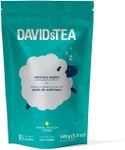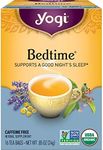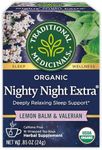Buying Guide for the Best Sleep Teas
Choosing the right sleep tea can make a big difference in your nightly routine and overall sleep quality. Sleep teas are herbal blends designed to help you relax and prepare for restful sleep. When picking a sleep tea, it's important to consider what ingredients are included, how the tea tastes, how easy it is to prepare, and whether it fits your personal preferences and sensitivities. Understanding the key aspects of sleep teas will help you find one that supports your sleep goals and fits seamlessly into your bedtime habits.IngredientsIngredients are the herbs and botanicals used in the tea blend, and they are crucial because different herbs have different effects on relaxation and sleep. Common ingredients include chamomile, valerian root, lavender, lemon balm, and passionflower. Some blends may also include additional calming herbs or natural flavors. If you are sensitive to certain herbs or have allergies, always check the ingredient list. To choose the right blend, think about your needs: if you want gentle relaxation, chamomile or lavender might be enough; if you struggle with falling asleep, valerian root or passionflower could be more effective. Always consider your own sensitivities and preferences when selecting ingredients.
Caffeine ContentCaffeine content is important because caffeine is a stimulant that can interfere with sleep. Most sleep teas are naturally caffeine-free, but it's always wise to double-check, especially if you are sensitive to caffeine or want to avoid it completely before bed. If you are very sensitive to caffeine, look for teas that are clearly labeled as 'caffeine-free' or 'herbal.' For most people, any herbal tea without added black or green tea will be suitable for nighttime use.
Flavor ProfileFlavor profile refers to the taste and aroma of the tea, which can range from floral and sweet to earthy or minty. This is important because enjoying the taste of your tea makes it more likely you'll stick to your bedtime routine. If you prefer mild and floral flavors, look for blends with chamomile or lavender. If you like something more robust, teas with valerian or licorice root might appeal to you. Consider your taste preferences and try small amounts or sample packs if you are unsure.
Preparation MethodPreparation method describes how the tea is made, such as loose leaf, tea bags, or instant powders. This matters because convenience and ease of use can affect how often you use the tea. Tea bags are quick and easy, making them ideal for busy routines, while loose leaf teas may offer a richer flavor but require more effort and equipment. Instant powders are the fastest but may have added ingredients. Choose a preparation method that fits your lifestyle and how much time you want to spend making tea before bed.
Potential Side EffectsPotential side effects refer to any unwanted reactions you might have to certain herbs, such as drowsiness the next day, allergies, or digestive discomfort. This is important because some herbs, like valerian root, can cause grogginess in some people, while others may trigger allergies. If you are new to sleep teas, start with blends that have milder herbs and avoid those with ingredients you know you are sensitive to. Always read labels and, if you have health conditions or take medications, consult with a healthcare provider before trying new herbal teas.















